You have /5 articles left.
Sign up for a free account or log in.

Students study in the Center for Environmental and Life Spaces, one of the pit stops on the Commuter Pit Stop Map.
Mike Peters/Montclair State University
Finding the perfect place to take a break, eat a snack or study up before the next class can be a challenge for all students, but especially for commuter students without an on-campus residence to retreat to.
Montclair University’s Pit Stop Map provides commuter students locations of places to recharge and stay engaged on campus and has encouraged positive change on campus.
What’s the need: When he came into his role seven years ago, there was little to no programming for commuter students, says Antonio Talamo, assistant director of the Student Center and Commuter Life.
Yet around 15,000 of Montclair State’s 20,000 students—75 percent—are commuters.
The only space identified as a commuter zone was the Commuter Commons, housed in the Student Center near the quad on campus. The Commuter Commons, however, could be booked in advance, limiting its availability for the average student, and it lacked basic services, like a microwave.
Talamo tasked some student employees with identifying any place on campus that could be used for studying, and then he created an online and printed map, identifying “pit stop” places.
Talamo partnered with Student Communications to modify the more general campus map to reflect commuter pit stops and other resources, including vending machines, dining options, microwaves, quiet spaces and couches.
What it is: The map is simple, highlighting any location on campus with a table, chair and electrical outlet for a student to use.
Those three features were intentional, Talamo says. “If you [commuters] were going to show up to the space, I don’t want you to do more work,” but instead be able to use it as is.
Talamo’s team found over 20 locations within 14 buildings that qualified as pit stops. Each year, someone revisits locations to ensure they’re suitable to be featured.
Talamo prints around 2,500 maps at a time and distributes them to campus resource areas like the admissions information desk and at tabling events.
The impact: Talamo jokes his team built 21 lounges on campus with zero budget simply by reframing what’s in those spaces to be commuter-friendly.
While Montclair doesn’t track how much students use the pit stops, Talamo has seen commuter student engagement on campus grow since implementing the maps.
Other campus partners have gotten engaged, Talamo says, by advertising their space as an option for a commuter pit stop or by increasing their amenities to provide for commuters.
Montclair’s Office of Social Justice and Diversity, for example, wanted to be recognized as a public space, so it added a microwave and requested its addition to the Pit Stop Map.
Driving on: In the future, Talamo hope to get further university buy-in on creating commuter spaces. Most of the locations listed are public, but by building off the idea of a pit stop, he imagines departments would add more resources to further attract commuters to stick around for a while.
Tell us something creative, and effective, your college or university has done to better serve commuter students.




